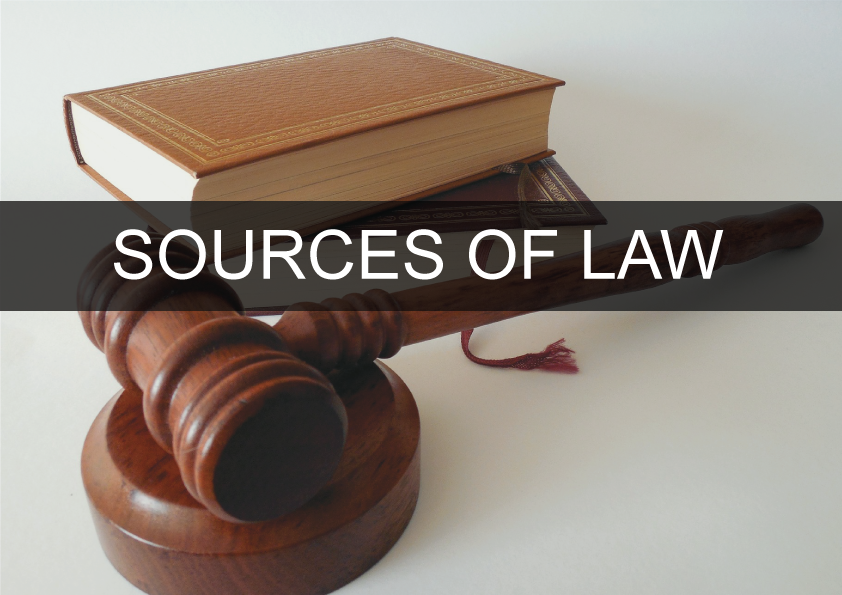The authority from which the laws acquire their power is meant by this statement.

Table of Contents
Sources of the Law: This term refers to the authority from which laws acquire their power.
The people or their representatives have the ability to make all laws, and none can have any force derived from any other source. However, it is not necessary for the legislator to specifically pass upon all laws and offer his mark of approval before they may acquire life or existence. The laws are therefore those that have gained explicit sanction, as opposed to those that get their authority and effect through implication.
1. The first, or express, is the United States Constitution, as well as the treaties and actions of the legislature enacted under the power conferred by the Constitution. To this must be added the state Constitution and the legislation enacted by the state legislature or other subordinate legislative bodies under the power granted by the state Constitution. The latter, or tacit, gained its force via widespread public usage, when they take on the appellation of traditions through the adoption of norms by courts from systems of foreign law.
The explicit laws are as follows:
The United States Constitution
Treaties concluded with foreign countries;
The congressional actions
The separate state constitutions
The legislation enacted by the various state legislatures
Laws enacted by lesser legislative bodies, such as municipal corporation councils
The broad guidelines established by the courts
The Constitution is a people’s act, enacted by representatives chosen for that reason. It is the ultimate law of the nation, and it is obligatory on all future legislative bodies, unless it is revised by the power of the people in the way provided for in the document itself, and any act made contrary to the provisions of the Constitution is ipso facto null and invalid.
Treaties negotiated under the authority of the Constitution are proclaimed to be the ultimate law of the nation, and therefore binding on courts.
Acts and resolutions of Congress passed in accordance with the Constitution are, of course, legally enforceable and need no more explanation.
The various state constitutions, if not in conflict with the provisions of the United States Constitution, are of binding effect in the respective states, and no act of the state legislature has any force if it is adopted in violation of the state constitution.
The laws of the several states, as enacted by state legislatures under the Constitution, have full and complete authority in their respective states.
Laws are regularly enacted by lesser legislative bodies that are authorised by the legislature, such as city or borough councils. Ordinances are the common term for their laws, and when legitimately issued, they are obligatory on the people. The courts have been in the business of adopting broad norms and orders, which sometimes influence suitors and parties as much as the most regular legislation established by legislature. These are applicable to all future situations. There are also regulations that are formed in specific instances as they emerge, but they are more like decrees or judgements than laws.
The implicit laws, which draw their power from the agreement of the people without any legislative action, may be split into two categories: the first is common law, which is taken from two sources: English common law and the practise and judgments of our own courts. In many circumstances, determining what this common law is is very difficult, and it is always humiliating to the courts. It has been legislated in several states that the common law of England should be the law, save when it conflicts with our Constitutions and statutes.
2. Customs that have been widely embraced by the people have legal force.
3. The concepts of Roman law, which are often based on greater intellect, have infiltrated every aspect of the law. Many of the refined principles that currently beautify the common law emerge there without any acknowledgement of their ancestry, and it is to this source that some judges go for the wisdom that graces their decisions. The processes of equity courts, as well as many of the exquisite distinctions that demonstrate their wisdom, are taken from this source. The courts of admiralty owe the majority of the law that controls in admiralty matters to this source of knowledge.
4. Canon law, which was approved by the ecclesiastical courts, is incorporated into our laws governing marriage, divorce, wills and testaments, executors and administrators, and a variety of other topics.
5. The jurisprudence, or rulings of numerous courts, has given its fair part to what constitutes the law. These judgements are made by following precedents, drawing from previously listed sources, and, sometimes, by the less excusable inclination of the judges to legislate from the bench.
The records, reports of cases adjudicated by the courts, and treatises of educated men are the monuments where the common law may be discovered. The volumes of reports are the finest evidence of what is common law, but due to the difficulties of establishing any systematic order, treatises on the many disciplines of the law are used. The records are seldom utilised since they are held in a single location and hence are not widely accessible.
